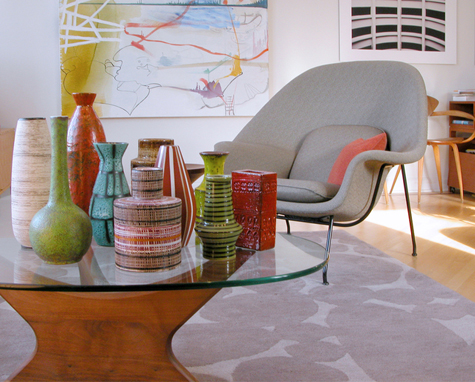Thonet

In 1830 Michael Thonet experiments with bending steamed wood to create furniture. Thonet and his sons then begin to produce innovative bentwood furniture, which became known for being practical, inexpensive and refined.

The impact of Thonet was extraordinary and far reaching. Thonet affected the business of furniture, the avant-garde art establishment, and the design process of many products, from his own day to the present. Thonet developed the mass production techniques of bentwood furniture, but was not the only one to employ them. Soon after his original patents expired, plenty of imitators emerged. In the 1890's over 50 bentwood furniture makers were in business, however none were able to challenge Thonet's dominance of innovation. As far as production numbers, his #14 bistro chair remains one of the most produced chairs in history...still being produced today by Gebrüder Thonet.
(via)

The development of bent and laminated wood veneers was one of those significant innovations of the 20th century, that made it possible to construct furniture using fewer pieces and allowing designers to obtain greater visual unity and fluidity.
Thonet patented a process of bending under heat several layers of wood veneer glued together and laminated—and used the new material to create curved back-rails and legs on chairs, contoured headboards for beds and scrolled arms for sofas.
By 1900, the curvilinear furniture made possible by Thonet's techniques were widely produced by furniture manufacturers in the U.S., where the process was exploited to for mass production of simple, inexpensive chairs and tables.
Thonet also developed a method of bending solid wood and his bent solid and laminated beech chairs with woven cane seats and backs remain among the most successful industrial designed products of all time. Josef Hoffmann, Otto Wagner and Adolf Loos, all of whom designed for Thonet, made use of his bentwood techniques to create classic chair designs still produced or copied today. Le Corbusier later used Thonet furniture in his Pavilion de l'Esprit Nouveau at the 1925 Paris Exhibition.
The chairs presently designed by Gebruder Thonet have been in continuous production for over 100 years and are made in much the same manner as their 19th century predecessor. Using the process of steaming and bending wood to create pieces that are light yet strong with graceful fluid lines.
(via)





A few of the rarer and more unusual examples of Thonet pieces incorporating the bent metal construction and bent ply made popular by Bauhaus and modernist designers at the turn of the century are available currently, including:





(via)

The development of bent and laminated wood veneers was one of those significant innovations of the 20th century, that made it possible to construct furniture using fewer pieces and allowing designers to obtain greater visual unity and fluidity.
Thonet patented a process of bending under heat several layers of wood veneer glued together and laminated—and used the new material to create curved back-rails and legs on chairs, contoured headboards for beds and scrolled arms for sofas.
By 1900, the curvilinear furniture made possible by Thonet's techniques were widely produced by furniture manufacturers in the U.S., where the process was exploited to for mass production of simple, inexpensive chairs and tables.
Thonet also developed a method of bending solid wood and his bent solid and laminated beech chairs with woven cane seats and backs remain among the most successful industrial designed products of all time. Josef Hoffmann, Otto Wagner and Adolf Loos, all of whom designed for Thonet, made use of his bentwood techniques to create classic chair designs still produced or copied today. Le Corbusier later used Thonet furniture in his Pavilion de l'Esprit Nouveau at the 1925 Paris Exhibition.
The chairs presently designed by Gebruder Thonet have been in continuous production for over 100 years and are made in much the same manner as their 19th century predecessor. Using the process of steaming and bending wood to create pieces that are light yet strong with graceful fluid lines.
(via)





A few of the rarer and more unusual examples of Thonet pieces incorporating the bent metal construction and bent ply made popular by Bauhaus and modernist designers at the turn of the century are available currently, including:








Yes excellent, Thonet has been a huge influence on myself and many others in my industry. His manufacturing techniques like Henry Ford's allowed great products to be acquired by less well off consumers. If you haven't already read it I would recommend - Bent Ply: the art of plywood furniture by Dung Ngo and Eric Pfeiffer
ReplyDeleteLiam